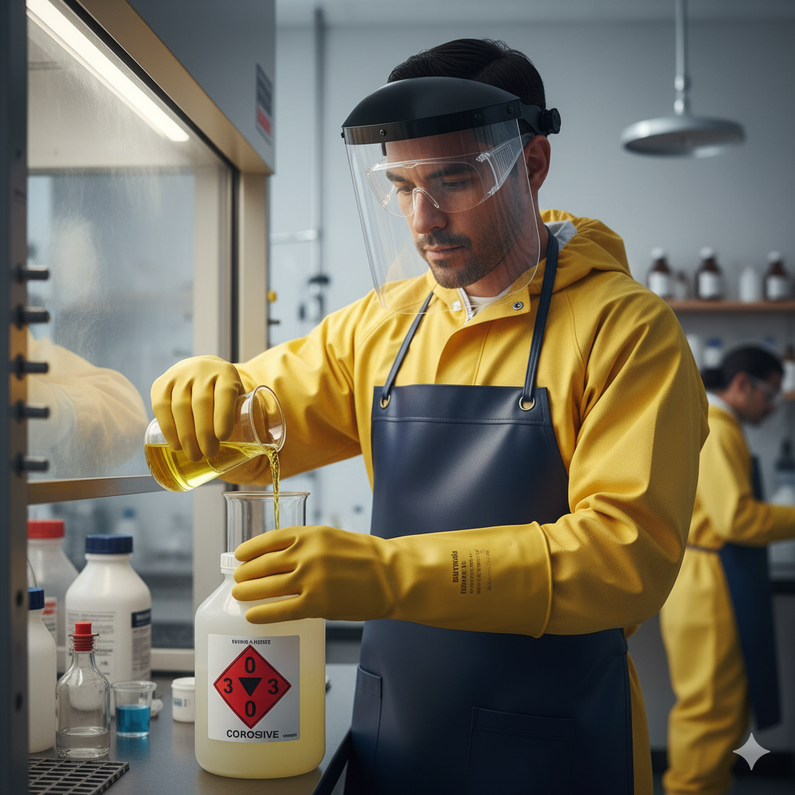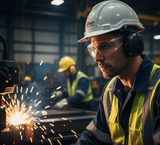The Acid Test: Essential PPE for Nitric Acid Protection
Nitric acid (HNO3) is a powerful chemical found across various industries—from metal etching and fertilizer production to laboratory synthesis. While indispensable, it is exceptionally hazardous, posing both immediate chemical burn risks and long-term health dangers due to its corrosive and oxidizing properties.
For safety managers and workers dealing with this chemical, selecting the correct Personal Protective Equipment (PPE) is not just a recommendation—it is a life-saving necessity.
At Your Safety Company, we stress that protection must be comprehensive, with chemical-resistant gloves being the frontline defense. Here is your essential guide to PPE and glove selection for safely handling nitric acid.
The Chemical Challenge: Why Nitric Acid is Different
Nitric acid presents a dual threat:
-
Corrosive: It causes severe, rapid damage to the skin, eyes, and respiratory system.
-
Oxidizer: It can accelerate combustion and react dangerously with many common materials (including some glove types), breaking them down quickly and producing toxic nitrogen dioxide (NO2) fumes.
Due to this aggressive nature, many common chemical gloves (like natural rubber or thin vinyl) fail rapidly when exposed to anything above very low concentrations of nitric acid.
? The Critical Barrier: Nitric Acid Resistant Gloves
When selecting gloves, chemical compatibility charts are your most critical tool. Protection must be chosen based on the concentration (%) of the acid and the duration of expected contact.
-
Butyl Rubber: Highly Recommended (Best overall). Offers excellent resistance to oxidation and permeation by concentrated acids. A top choice for immersion and long-duration exposure.
-
Viton®: Excellent protection, especially against higher concentrations, but is generally more expensive.
-
Neoprene: Good/Moderate resistance. Suitable for lower concentrations (typically under 40%) and splash protection. Ensure thickness is adequate.
-
Nitrile: Not Recommended for High Conc. Permeates quickly, especially with concentrated acid. Only suitable for very dilute solutions or very brief splash risk. Never use for immersion.
Crucial Note: Always check the manufacturer's specific chemical resistance chart for the exact concentration you are handling. The required thickness (mil) is just as important as the material.
?️ Full-Body Protection: Essential Supplemental PPE
Gloves alone are not enough. Nitric acid vapors and splashes require comprehensive head-to-toe protection:
-
Eye and Face Protection: Always wear tightly fitting chemical splash goggles. Safety glasses are insufficient. For any pouring or mixing tasks, a full face shield must be worn over the goggles.
-
Body Protection: Use a chemical-resistant apron (made of neoprene or PVC) over chemical-resistant suits or coveralls. The fabric of the coverall should be rated for acid splash (e.g., laminated polypropylene).
-
Foot Protection: Wear acid-resistant boots (usually PVC or butyl) with steel toes if required. Pant legs must go over the boots to prevent acid from pooling inside.
-
Respiratory Protection: Handling concentrated nitric acid or working in poorly ventilated areas can lead to exposure to toxic NO2 fumes. An approved respirator with an acid gas cartridge (like an OV/AG cartridge) is often required. Air monitoring is essential to determine the exact need.
The Right Procedure: Use and Care
The best PPE is useless if not used correctly. Implement these procedures:
-
Inspection: Always inspect gloves for pinholes, cracks, or signs of degradation before use.
-
Decontamination: Follow specific procedures for washing gloves and other PPE immediately after contact or before removal.
-
Doffing: Remove contaminated PPE carefully to avoid contact with the unprotected skin. Gloves should be the last item removed.
By meticulously matching your PPE to the chemical concentration and exposure risk, you ensure your team is fully protected against the serious hazards posed by nitric acid.
Recent Posts
-
The 2026 Safety Checklist: Is Your Crew Truly Protected?
As we move into the new year, it’s the perfect time to look past the daily grind and evaluate the ge …23rd Dec 2025 -
Beyond the Buzz: Why Proper Hearing Protection is Non-Negotiable on Your Job Site
On any given workday, the sounds of progress—drills, saws, heavy machinery, and even loud conversati …22nd Dec 2025 -
The Frameless Revolution: Why "Less" is Actually "More" for Your Vision
When it comes to safety eyewear, the frame is often the first thing people notice. But for many indu …19th Dec 2025



